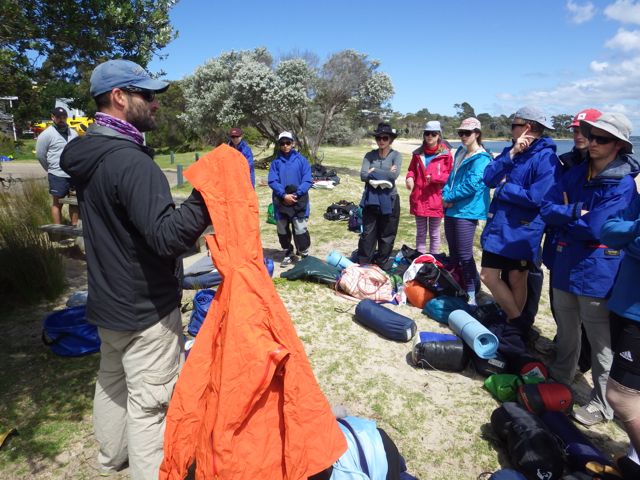 Loading... Please wait...
Loading... Please wait...Categories
Sea Kayaking Safety Guidelines
---------------------------------------------
East Coast Kayaking has been providing kayaking activities for schools since 1997.
We provide a safe adventure-based platform for education outdoors to achieve educational outcomes.
East Coast Kayaking aligns all activities in accordance with Australian Canoeing, Dept Education Victoria, Maritime Safety Victoria guidelines and Australian Activity Standards.
Skills and Briefing 
Students' prior experience, skills and knowledge are assessed at the start of the activity.
Instructional staff brief the group at the start of each session. For overnight programs an in-school briefing can be arranged to ensure proper preparation and to review student's and school's gear lists.
Briefings include:
- Journey Overview / Navigation
- Communication & Group Management
- Weather
- Clothing
- Strokes
- Capsize drill
- Packing a kayak (overnight expeditions)
Sample briefings are available on Youtube to assist in the school's planning process - for day programs, packing for overnight journeys and food preparation.
Equipment
Kayaks
Craft are matched to the activity undertaken - sea kayaks or sit-on-top kayaks. All craft have sufficient permanent upthrust to prevent sinking if capsized. Sea kayaks have sealed bulkheads fore and aft to create buoyant compartments.
Kayaks have sufficient structural strength sufficient to withstand the intended use and to minimise the likelihood of entrapment. Cockpits are clear of attachments and smooth on the edges to enable a quick and safe exit.
All craft have permanent hand loops/ toggles at stern and bow of sufficient strength for use in rescues and boat retrievals. Sea Kayaks have deck-lines and tow-point attachments fitted.
Repair methods and equipment vary according to the construction materials of the craft. Repair tape is carried and used for temporary repairs, as long as the structural integrity of the craft is maintained, with permanent repairs effected as soon as possible.
Paddles
Paddles are buoyant and in good working order, suitable for the activity and the correct length for the paddler.
Personal Floatation Devices (PFD)
All staff and students will wear a securely fitted Australian Standard Type 2 or high-visibility Type 3 personal flotation device which complies with Maritime Safety Victoria regulations on all waters. Participants will be briefed as to correct fit of their PFD prior to commencing the activity.
Spray decks
Spray decks are fitted with release tapes. All students and staff are briefed at the start of the activity how to exit their craft in the event of a capsize.
Helmets
Helmets specifically designed for water activities are worn when participating in a kayaking activity on moving water or where the activity involves entry or exit through the surf zone. Otherwise, helmets may be provided after consideration of:
- participants’ kayaking experience and skill
- the risk of participants sustaining a head injury due to the nature of the activities being undertaken during the session.
First Aid Kits
First aid kits appropriate to the location and level of staff training are carried.
Rescue Equipment
Rescue equipment suitable for the location of trip and category of water conditions is readily accessible. Staff are proficient in its use.
Clothing
Clothing is the individual’s primary protection against extreme and variable weather conditions. Clothing lists are provided that are appropriate for the activity, the environment and the season. For overnight touring a complete change of clothing should be available and carried in waterproof containers.
Participants must wear footwear suitable both for in the craft and for use in the event of a capsize or a walkout.
Participants should be SunSmart and protect against sunburn - wear a hat, and use broad-spectrum, water-resistant sunscreen (at least SPF 30+) on all exposed parts of the body, applied according to the manufacturer’s recommendations.
Participants must dress in a manner that will not hinder flotation, eg. clothing should not be bulky; no heavy boots. The PFD will be worn on top of all other clothing.
Glasses should be secured to avoid loss.
More information on Clothing the we use and recommend is available here.
Communications
Instructional staff carry Telstra mobile phones as well as VHF Marine Radio where appropriate. A Float Plan is prepared for each activity that includes contact details for local emergency and rescue services. A Satellite phone is available for remote programs in areas where there is no cell coverage.
A system of communication signals is utilised on water for simple communications within the group - paddle signals and whistle blasts - see Youtube for examples.
Identification
Staff and students are easily identifiable on East Coast Kayaking activities, through use of uniform set of kayaks, PFDs and where appropriate, paddling jackets. Staff are introduced at the start of the activity.
Touring
All touring parties carry with them appropriate safety and rescue equipment including:
- towing systems - 15m tow line and contact tow
- rescue knife
- repair kit
- spare paddle
Touring parties have a full Float plan that includes contingency plans and strategies for dealing with delays. This plan is left with the school contact person.
Instructional staff are knowledgeable about the changeable nature of the weather and water environment they will be visiting and aware of the amount of time that may be required.
To determine whether students may participate in touring, consider:
- the physical fitness and skill level of each member of the group
- unpredictable delays such as capsizes and craft repair
- time for rest periods
- forecast and seasonal weather conditions including tides and current, wind and waves.
When planning sea touring, the instructor takes into account the cumulative effects of tidal influence, winds and sea breezes, potential hazards and distance from shore. Sound judgment about weather conditions, high winds and lightning will be exercised if open crossings are planned.
All expedition parties will carry with them the appropriate safety and rescue equipment. First aid equipment and extra clothes are carried.
All essential dry equipment (food, clothing, sleeping gear, stoves, camping equipment, toilet gear, first aid kit, communication equipment, matches and repair kits) is evenly distributed amongst the craft and carefully stored.

